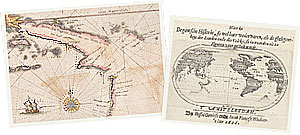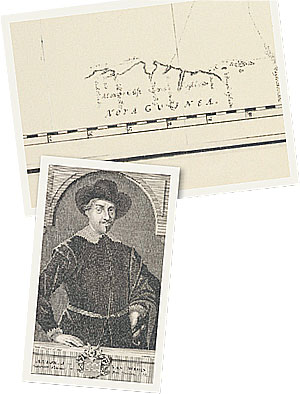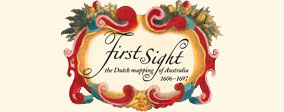Press Article
COAST BUSTERS: A desire for riches beyond measure drove the early Dutch explorers over the very edge of the known world.
Wherever profit leads us, to every sea and shore, For love of gain the wide world's harbours we explore.
Dutch poet Joost van den Vondel (1587-1679) on the occasion of the state visit of Marie de Medici to East India House, Amsterdam, 1639.
 PLOT SHOTS Hendrik Hondius' 1641 map
PLOT SHOTS Hendrik Hondius' 1641 mapof New Guinea joined to Cape York, left,
and a 1626 map showing Hartog's Land
Eendracht anchorage
MONEY MADE THIS COUNTRY, though not perhaps in the sense usually intended. It was pursuit of profit that led to the European discovery of Australia 400 years ago this year. The Dutch East India Company, based in Java, was beginning its ascent. It would become the greatest trading company in the world. To discover the Great South Land, long reputed to be the source of fabulous wealth, would be a good business move. It would also forestall foreign competitors. The company's idea of market share was a monopoly.
To this end, Willem Jansz (c.1570-c.1638) was sent out on the ship Duyfken (little dove) in late 1605 "to discover the great land Nova Guinea and other unknown east and south lands". Jansz charted parts of New Guinea's south coast and then sailed south-east, past the entrance to Torres Strait (without realising it was a strait), and down the west coast of Cape York. This was in March 1606. He sailed as far as Cape Keer-weer (turnabout), which he named because he did just that, and headed back home. Cape Keer-weer is the oldest Australian place name given by a European.
Two other names which Jansz placed on his map are of interest. "R. met het Bosch" (river with the bush) was his name for what is now the Pennefather River, just north of Weipa. The Dutch "bosch" is the derivation of our word "bush" used in the Australian sense of unsettled areas. It came to us from the Dutch in South Africa via the American colonies. Fitting, then, that it should be one of the first words inscribed on our map. And towards the top of Cape York, Jansz placed the word "Moent". No one seems to know what this word means. It is not Dutch. Recent research suggests it may be a Dutch transcription of an Aboriginal word meaning "coals, charcoal, cremation ground". So Jansz may be credited with placing the first Aboriginal name on our map as well. Tragically, the first fatal encounter between the Aborigines and the Europeans occurred on this voyage, at the Wenlock River.
 GOING DUTCH The chart of Jansz’s 1606 voyage
GOING DUTCH The chart of Jansz’s 1606 voyageon Duyfken (north is to the right), above, and Dutch East India
chief Anthony van Diemen, left
Jansz did not realise he was the first to see the Great South Land and thought that Cape York was a continuation of New Guinea. Nothing of value had been found and further exploration was put on hold. A number of accidental encounters with Australia's western coast followed, when ships sailing from the Netherlands to the East Indies across the Indian Ocean did not turn north soon enough. Dirk Hartog (1580-1621) found himself at Shark Bay in this way, in October 1616. On the island that today bears his name, he left a pewter plate recording his visit. The plate would remain, exposed to the elements for 80 years, until 1697, when another Dutch voyager, Willem de Vlamingh, removed it and replaced it with one of his own. Truly, these Dutch did "bring a plate"!
Hartog's major discovery posed the question: was this coast connected to Jansz's New Guinea or was it part of a separate south land? Further accidental sightings of the west coast resulted in the charting of much of this coast, and one voyage in 1627 even extended along the south coast as far as the Great Australian Bight.
In January 1623, another voyage of discovery was mounted. Jan Carstensz's route was similar to Jansz's. He, too, failed to find Torres Strait. But he went further south than Jansz and reached a river on April 24 which he named "Staten" after the States-General of the United Provinces of the Netherlands.
It was the voyages of Abel Tasman (1603-1659) which were the apogee of Dutch charting of Australia. These were initiated by the head of the Dutch East India Company in Batavia (now Jakarta), Anthony van Diemen, for whom the profit motive was combined with the wish to complete the jigsaw puzzle which the Dutch had partly assembled: were the discoveries on the north, west and south coast linked?
On his first voyage, from August 1642 to June 1643, with the two vessels Heemskerck and Zeehaen and a crew of 110, Tasman charted the southern part of Tasmania (which he named Van Diemen's Land), the west coast of New Zealand, and parts of Tonga and Fiji. It was a remarkable voyage. But van Diemen was not amused: Tasman had found nothing valuable. Further, he had not investigated the situation and nature of the lands and peoples discovered. Although he had claimed Van Diemen's Land for the Netherlands by having the ship's carpenter swim ashore with a flag and flagpole, he had not set foot himself on Tasmanian soil. Nor had he followed its coasts to see whether it was an island or connected to the other Dutch discoveries.
In spite of the criticisms, Tasman received a consolation prize. He was told to trace the coast from Cape York to see whether it connected with the Dutch discoveries on the west coast. If there were a strait leading from Cape York to the Pacific (which van Diemen thought unlikely), Tasman should sail through this and south to Van Diemen's Land, establishing the precise relationship of it to other Dutch discoveries.
On January 29, 1644, Tasman left Batavia with three vessels, Limmen, Zeemeeuw and Bracq, and 111 men. He did not find Torres Strait. He did, however, chart the coast from western Cape York, along the Gulf of Carpentaria, the north coast, and the north-west coast as far as today's North West Cape (Exmouth). He landed on at least 10 occasions and charted more of the Australian coastline than any other explorer before or since.For van Diemen it was not enough: "They did not discover anything important, but only found wretched naked beachcombers without rice or other valuable produce and in many places wicked men." Exasperated at so much worthless new land, he exclaimed, "God grant but one rich silver and gold mine ... to the solace of the general shareholders and honour of the finder". The company was very modern in its concern for shareholder value.
By 1644, the north, west and half the south coast of the continent and the southern half of Tasmania had been charted by the Dutch. The great Dutch map-maker, Joan Blaeu, attached the name Nova Hollandia (New Holland) to the northern part of the continent – but it was only a paper claim. The Dutch lost interest because there was no money to be made and, apart from Willem de Vlamingh's additions to the West Australian coast in 1697, the map of Australia remained for 125 years as Tasman left it – until Cook in 1770.
Paul Brunton is the senior curator, Mitchell Library, Sydney. The exhibition First Sight: the Dutch Mapping of Australia, 1606-1697 is at the State Library of NSW, March 6-June 4, 2006, featuring Tasman's manuscript journal of 1642-43, the Bonaparte map recording Tasman's 1644 voyage, and Hessel Gerritsz's rare 1628 chart.

ISLAND SIDE Detail from a pen and ink sketch of the Van Diemen's Land coast done during Tasman's 1642-43 voyage














